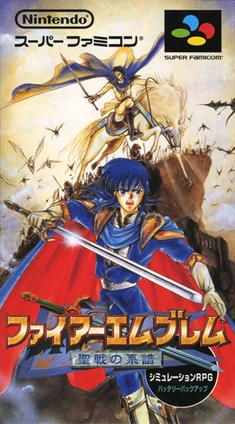
Fire Emblem: Genealogy of the Holy War is a tactical role-playing game developed by Intelligent Systems and published by Nintendo for the Super Famicom home video game console in 1996. It is the fourth installment of the Fire Emblem series, and the second to be developed for the platform. Genealogy of the Holy War takes place on the continent of Jugdral, split between eight countries founded by the Twelve Crusaders, an ancient group of soldiers who ended the rule of the ancient dragon Loptous with divine aid. In the present, a cult working to revive Loptous stirs up war among the countries. The story is told over two generations—the first generation follows the Grannvalian prince Sigurd, while the second follows his son Seliph as he works to defeat the cult and avenge his father. Gameplay follows the traditional Fire Emblem system of tactical battles taking place on grid-based maps, while adding the Weapon Triangle and Support systems, which directly impacted both gameplay and story.
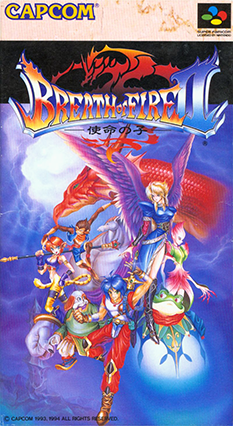
Breath of Fire II is a role-playing video game developed and published by Capcom. First released in 1994, the game was licensed to Laguna for European release in 1996. It is the second entry in the Breath of Fire series. It was later ported to Game Boy Advance and re-released worldwide. The game was released on Wii's Virtual Console in North America on August 27, 2007. Nintendo of Europe's website mistakenly announced it for release on July 27, 2007, but it was in fact released two weeks later, on August 10, 2007. In 2013, it was released for the Wii U Virtual Console. In 2016, it was released for the New Nintendo 3DS Virtual Console. In 2019, it was released for the Nintendo Switch SNES games library.
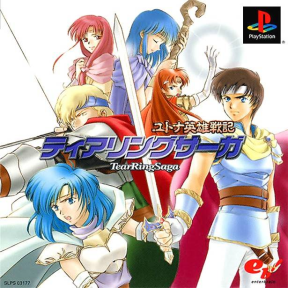
Tear Ring Saga: Chronicles of War Hero Yutona is a tactical role-playing game developed by Tirnanog, a development studio started by Shouzou Kaga, the creator of the Fire Emblem series, after he left Nintendo’s Intelligent Systems development team in 1999. The game featured a complicated development and initial release period, with the company receiving legal pressure multiple times from Nintendo, who felt that the game's very similar gameplay and presentation, which also featured the art of Fire Emblem: Thracia 776 artist Mayumi Hirota, infringed on their copyrights on their Fire Emblem intellectual property. Direct ties to Fire Emblem were dropped, and its original title, Emblem Saga, was changed to its final title as to not sound so similar to Fire Emblem, and the game was released in Japan on May 24, 2001, by Enterbrain, for Nintendo's competitor, Sony, on their PlayStation console. Three months after release, Nintendo took them to court over the game, and while Enterbrain was ordered to pay a fee, they ultimately retained the right to sell the game.

Breath of Fire III is a role-playing video game developed and published by Capcom originally for the PlayStation console as part of the Breath of Fire series. Initially released in Japan on September 11, 1997, the game was later released in North America and Europe in 1998. It is the first game in the franchise to feature three-dimensional graphics and voice acting. The title was developed by director Makoto Ikehara and features a unique jazz-inspired soundtrack by company composers Yoshino Aoki and Akari Kaida. On August 25, 2005, the game was ported and released for the PlayStation Portable handheld system in Japan, and was also released in Europe on February 3, 2006.

Breath of Fire IV is a role-playing video game developed by Capcom, and is the fourth game in the Breath of Fire series. It was originally released for the PlayStation home console in Japan and North America in 2000, and Europe in 2001. The game was later ported to Windows-based PCs in Europe and Japan in 2003.

Breath of Fire is a role-playing video game developed by Capcom originally for the Super Nintendo Entertainment System. Initially released in Japan in April 1993, the game was later made available in North America in August 1994 by Square Soft, who handled the title's English localization and promotion. It is the first entry in the Breath of Fire series.

The Legend of Dragoon is a role-playing video game developed by Japan Studio and published by Sony Computer Entertainment for the PlayStation in 1999 in Japan, 2000 in North America, and 2001 in Europe. Set in a high fantasy fictional world called Endiness, the game follows a group of warriors led by the protagonist, Dart, as they attempt to stop the destruction of the world. The player controls a party of 3D character models through pre-rendered, linear environments. Combat uses a combination of turn-based mechanics and real-time commands. Notably, the game includes a quick time event called "addition" during each attack, requiring the player to press a button when two squares converge.
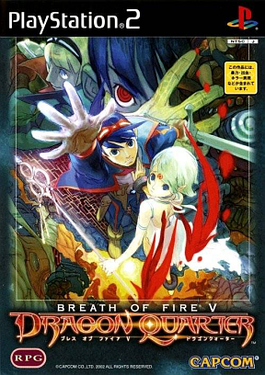
Breath of Fire: Dragon Quarter is a 2002 role-playing game by Capcom for the PlayStation 2. It is the fifth entry in the Breath of Fire series.

Fire Emblem: The Binding Blade is a tactical role-playing game developed by Intelligent Systems and published by Nintendo for the Game Boy Advance (GBA) handheld video game console. It is the sixth entry in the Fire Emblem series, the first title produced for the system, and the first title to appear on a handheld console. It was released in Japan in March 2002.
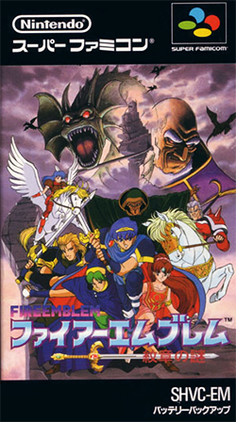
Fire Emblem: Mystery of the Emblem, known in Japan as Fire Emblem: Monshō no Nazo, is a tactical role-playing video game developed by Intelligent Systems, and published by Nintendo for the Super Famicom home video game console in 1994. It is the third installment of the Fire Emblem series, and the first to be developed for the Super Famicom. The story is divided into two parts: the first part is a retelling of Fire Emblem: Shadow Dragon and the Blade of Light, while the second is an original story acting as a sequel to the first game. After defeating the sorcerer Gharnef and the Dark Dragon Medeus, peace is restored to Archanea and Marth restores his kingdom. His ally Hardin ascends to the throne of Archanea, but begins hostile military expansion across the continent, forcing Marth to confront his old friend and the force driving him. Gameplay follows the traditional Fire Emblem system of tactical battles taking place on grid-based maps.
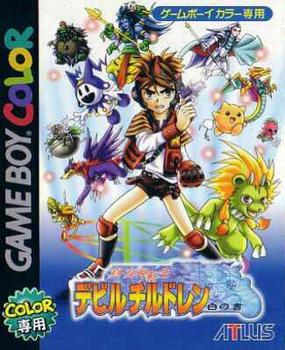
Shin Megami Tensei: Devil Children, also known as DemiKids, is a series of role-playing video games primarily developed by Multimedia Intelligence Transfer and published by Atlus. It is a spin-off from Atlus' Megami Tensei franchise, and began in 2000 with the Game Boy Color games Black Book and Red Book. Five more role-playing games and three games in other genres were released until 2004, followed by no new releases until the 2011 social game Shin Megami Tensei: Devil Children. In addition to the games, the series has been adapted into manga, anime, and a trading card game, and two soundtrack albums have been released by First Smile Entertainment.
The Breath of Firemobile phone game series is a group of mobile phone video games developed and distributed by Capcom based on their Breath of Fire role-playing franchise. Each game was created by the company's mobile game division for use on NTT DoCoMo, SoftBank, and au brand phone devices compatible with EZWEB, BREW, and i-mode services, and are distributed using paid downloads. Capcom released the first title, Breath of Daifugō, in August 2003, which was followed by additional games from a variety of genres up through November 2008. No entry in the Breath of Fire mobile games series has been released outside Japan.

Dragon's Dogma is a 2012 action role-playing hack and slash video game by Capcom. First released for PlayStation 3 and Xbox 360, an enhanced version subtitled Dark Arisen was later released for the same consoles in 2013, with ports releasing for Windows, PlayStation 4, Xbox One, and Nintendo Switch in the following years. Set in Gransys, a high fantasy world inspired by Sicily, the player takes on the role of a human protagonist dubbed the Arisen on a quest to defeat the dragon Grigori, a being said to herald the world's end, while uncovering a deeper conspiracy along the way.
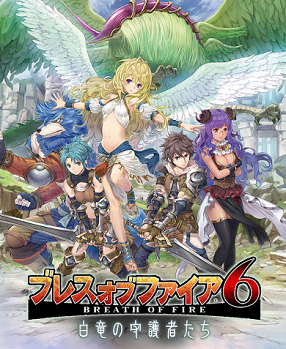
Breath of Fire 6: Hakuryū no Shugosha-tachi was a free-to-play online, web-based multiplayer role-playing video game with microtransactions developed and published by Capcom as the sixth main installment of its Breath of Fire series. The game was released in Japan on February 24, 2016 for Microsoft Windows computers and Android devices, with an iOS release following on July 12, 2016. Online operations for the title officially ceased on September 27, 2017.

Tales of Phantasia is an action role-playing video game developed by Wolf Team and published by Namco for the Super Famicom. Originally released only in Japan in December 1995, it is the first title in the Tales series. It was later ported to a number of other platforms, including a Japan-exclusive version for the PlayStation in December 1998 and a Game Boy Advance version published by Namco in Japan in August 2003 and later published by Nintendo in North America and Europe in March 2006, which marked the first time the game was officially available in English. A PlayStation Portable remake known as Tales of Phantasia Full Voice Edition followed in September 2006, featuring full voice acting during story scenes, which was later included with further enhancements as part of Tales of Phantasia: Narikiri Dungeon X in June 2010. The game's producers have given it the characteristic genre name Legendary RPG beginning with the PlayStation version, with the Full Voice Edition given the moniker Legendary RPG Embellished with Voices. An unofficial fan translation of the original Super Famicom version was released on February 12, 2001 by Dejap.
Kinu Nishimura is a Japanese video game and anime concept artist and illustrator. Currently freelance, she is best known for her character design and promotional art for Capcom's fighting games during the 1990s.
Cattle Call Inc. is a Japanese game developer based in Tokyo, Japan. The company was established by former staff of Data East Corporation and is engaged in developing original console games as well as co-developing and porting games for other game companies.













